Indoor flowers with purple leaves
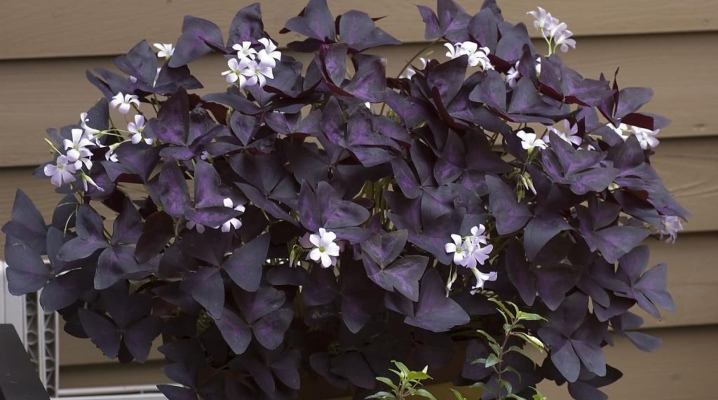
Indoor plants with unusual purple leaves able to organically fit into any interior, becoming its main decoration... Their spectacular appearance, health and well-being largely depend on the conditions of detention. What types of indoor plants with purple leaves are popular with flower growers? What are the features of caring for them?
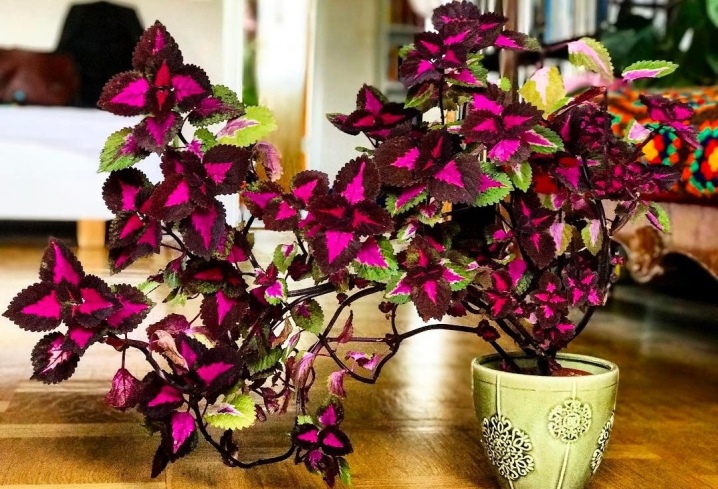
Peculiarities
Many novice florists are interested in the reason explaining the origin of the purple foliage color in some plant species.
This feature is due to the high content of a special pigment in their leaves - anthocyanin.
This pigment actively absorbs light in the green part of the spectrum, reflecting light in the violet, red and blue parts. This specificity of light absorption explains the unusual purple-lilac, blue-violet, maroon color of leaves in some representatives of the flora world.
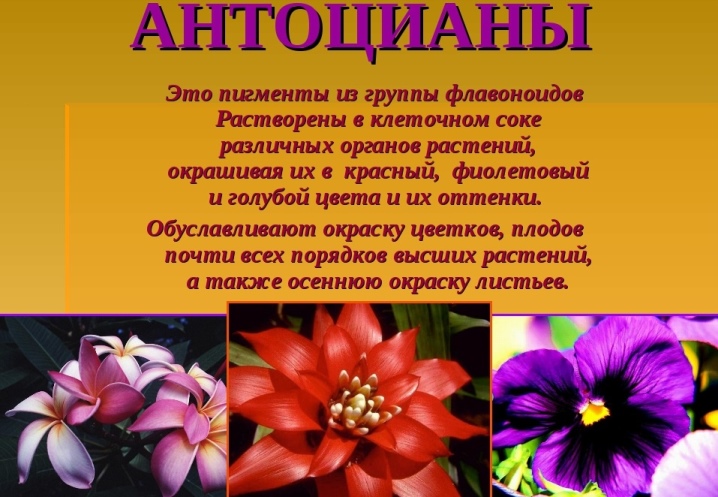
Otherwise, the process of light absorption occurs in plants with green foliage. Their leaves contain chlorophyll, a pigment that absorbs red, blue and violet light, but reflects light in the green part of the spectrum. This feature causes the green color of the leaves, so familiar to the human eye.

Experienced plant breeders know many names of indoor flowers with purple leaves. Below are the most popular varieties.
Types of plants with purple leaves on top
Triangular oxalis is a herbaceous houseplant, which is a representative of the acid family. This unpretentious perennial gained popularity in indoor plant growing thanks to its unusual foliage.

Oxalis leaves are trifoliate, dark purple above and light purple below. Visually, the leaves of the sorrel resemble the leaves of a shamrock clover. Many growers compare the leaves of the sorrel with large purple-ink butterflies sitting on thin long stems.
With the arrival of darkness, the leaves of the plant fold in a special way, taking the shape of a triangular pyramid.

When growing triangular acid, it is necessary to provide it with the following conditions of detention:
- optimal temperature regime (in summer - not higher than 25 ° С, in winter - not lower than 13 ° С);
- abundant but diffused lighting;
- frequent watering in hot weather, rare watering in cool and cloudy weather;
- top dressing at the beginning of the period of intensive growth.
During flowering, thin pale green or pale lilac peduncles about 15-20 centimeters long are formed on the plant. Flowers - small, delicate lavender, five-petal.
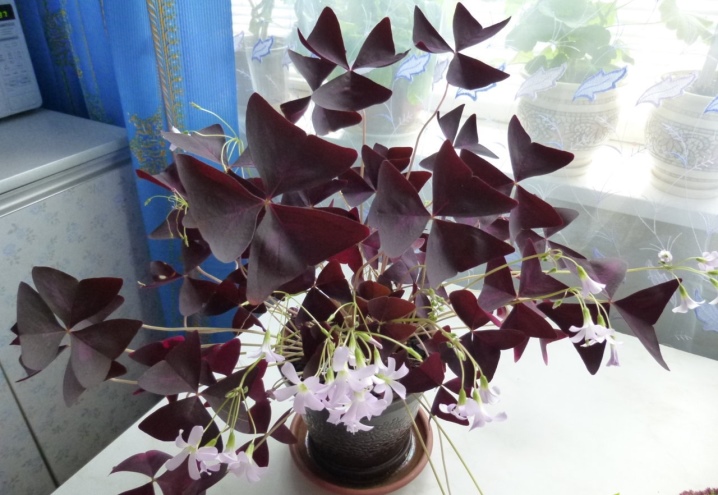
Flowers with colored underside
Tradescantia is a perennial ornamental deciduous plant of the Kommelinovye family. Its natural habitat is the tropical and subtropical forests of Mexico, America and the Antilles. It is a strong, powerful shrub with a fleshy erect stem. Plant height can vary from 30 to 50 centimeters. The leaves of Tradescantia sheath are glossy, elongated, xiphoid, reaching 20-30 centimeters in length, sitting tightly at the base. The upper side of the leaves is colored emerald green, the lower side is burgundy purple. Flowers - small, milky white, hidden in a dark purple compact bracts.
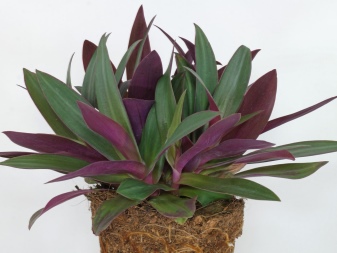
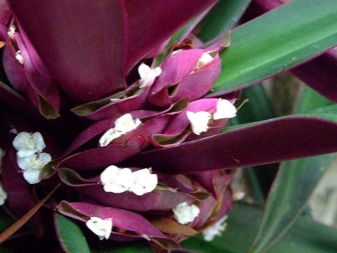
One of the most popular ornamental varieties of Tradescantia is the Hawaiian Gnome. Tradescantia of this variety forms small beautiful bushes about 30 centimeters high. Leaves - dense, xiphoid, tightly covering the base of the bush. The underside of the leaves is colored bright purple with a purple tint. The upper side of the leaves is emerald green, decorated with pearl gray longitudinal stripes. Covering Tradescantia is considered one of the most unpretentious plants with original leaf color.
She easily tolerates slight shading and bright light. The plant feels most comfortable in conditions of soft diffused lighting.
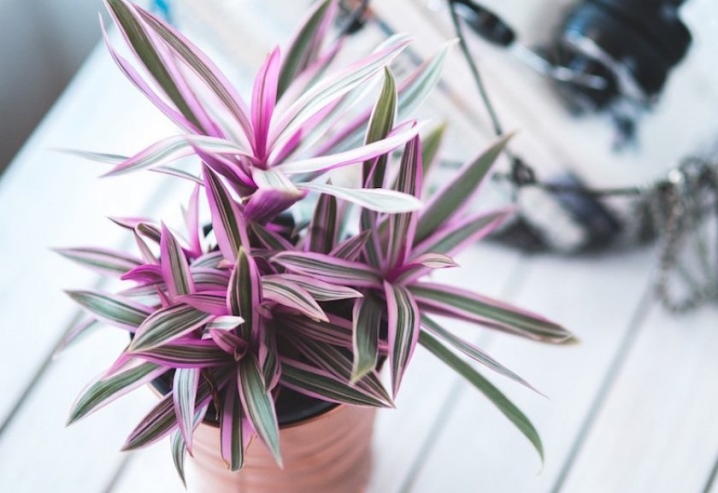
When growing this amazing exotic, it is important to maintain a comfortable room temperature for it. In the spring-summer period, the indoor air temperature should be about 21-23 ° С, in the winter period - about 19 ° С.
It is important to take into account that when the temperature drops below 13 ° C, the tradescantia can get sick and even die.

Among other requirements for the conditions of keeping this plant, the following should be noted:
- high humidity in the room;
- regular watering (in summer - 1 time in 2 days, in spring and autumn - 1 time in 3 days, in winter - 1 time in 4-5 days);
- lack of drafts in the room.
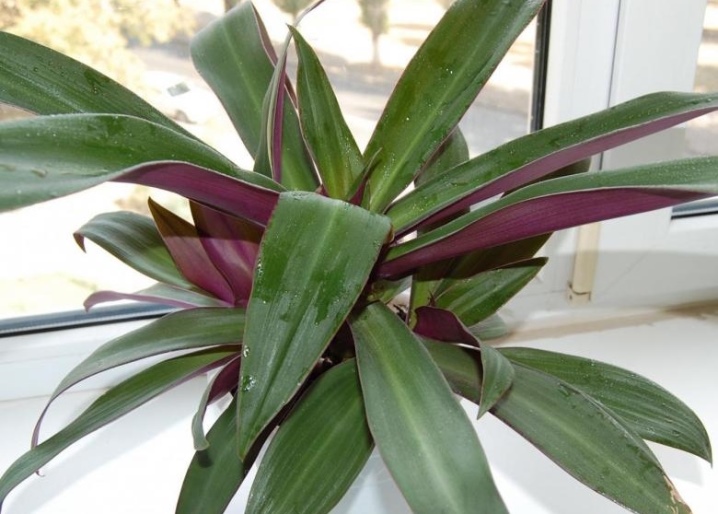
Gemigraphis (hemigraphis) is an exotic herbaceous perennial of the Acanthus family. In the wild, the plant is found in Asia, Malaysia, as well as in the Philippines and the island of Java. Depending on the species, the height of the plant can vary from 25 to 60 centimeters. Stems are creeping, creeping or erect. Leaves can be ovoid or lanceolate. The color of the leaf plates varies from purple-purple to burgundy-purple. In some species, the upper part of the leaves is colored silvery-green or bluish-purple, the lower one is deep purple. The flowers of the hemigraphis are small, pale pink or snow-white in color.

Gemigraphis are light-loving plants that are painful in shading. In the absence of abundant diffused lighting, these exotic species lose their decorative effect and spectacular appearance. The decorativeness of hemigraphis and direct sunlight are harmful.
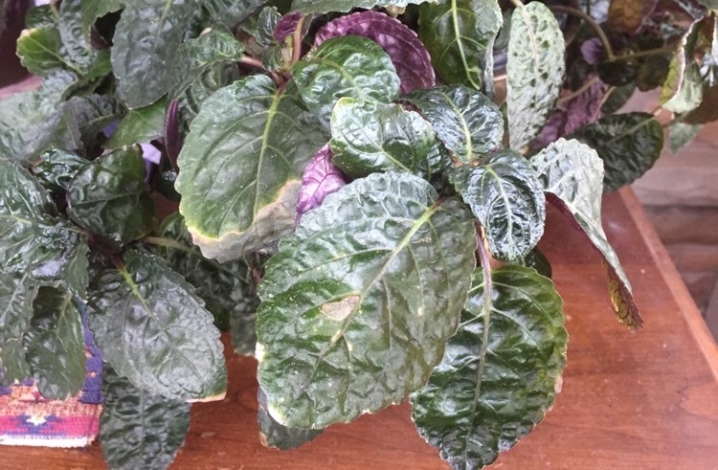
When growing hemigraphis, it should be borne in mind that it needs the following conditions of detention:
- stable temperature regime (in summer - about 24 ° С, in winter - about 18 ° С);
- lack of drafts;
- abundant soft lighting;
- regular spraying;
- stable air humidity in the room at 60%.
Experienced flower growers recommend watering the hemigraphis once every 2 days. It is important not to allow the earthen coma to dry out in the pot, since these exotic plants painfully tolerate a deficiency of soil moisture.

Ginura wicker - an exotic representative of the Astrov family... The natural habitat of this plant is the territories of East Africa and Asia. At home, ginura is most often grown as an ampelous culture. The average length of the creeping stems of the plant varies from 40 to 60 centimeters. Leaves are elongated, with a pointed tip and wavy edges.
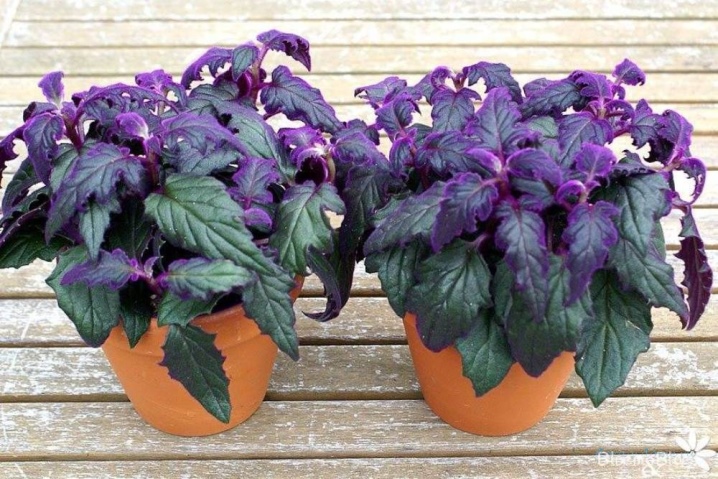
The plant is remarkable not only for its interesting shape, but also for the original color of the velvety foliage. The upper side of the carved leaf plates of the ginura is painted in a solid emerald color, contrasting with thin violet-lilac veins. At the base, the leaves are bright purple in color. Both the stems and the leaves of the ginura are covered with numerous soft dark lilac hairs.
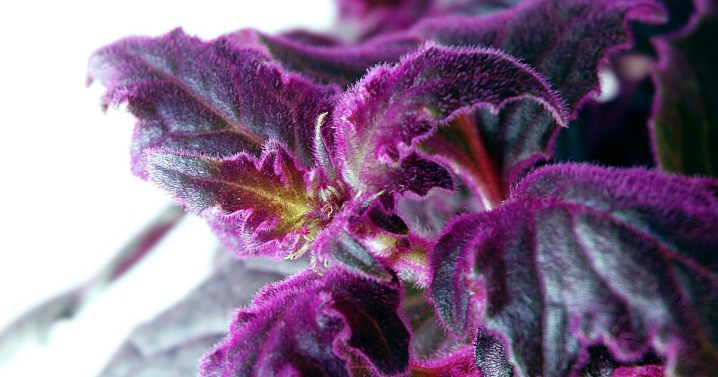
Ginura flowers are small, golden yellow, fluffy. It should be noted that even in the absence of flowering, this plant looks very attractive and unusual.
Ginura has a tendency to grow rapidly, which necessitates periodic pruning and pinching.
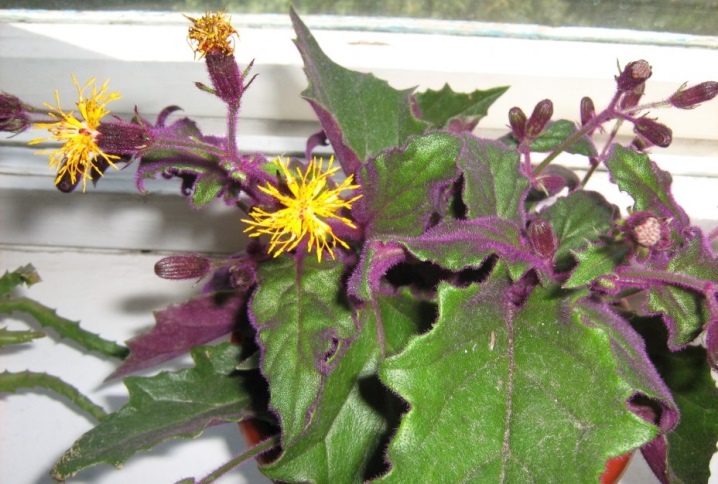
In addition, this plant requires:
- regular abundant watering;
- high air humidity;
- annual transplants;
- abundant but diffused lighting;
- well-drained soil.
For braided ginura stable temperature conditions are important... This plant does not tolerate both a sharp drop and a sudden increase in temperature. The most comfortable for her in the spring-summer period is the interval of 21-22 ° С, in the winter period - 13-14 ° С.
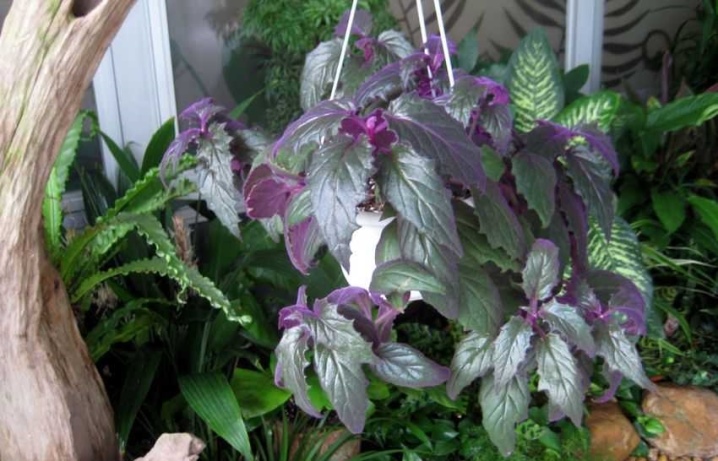
Varieties with spots and stripes
In the collections of experienced flower growers, you can often find such types of indoor plants, whose leaves are decorated with intricate patterns, spots and stripes of purple.

Royal begonia is a very effective representative of the Begonia family, which has gained wide popularity in indoor plant growing. In the wild, this unusual flower is found in the eastern part of India. The plant has strong creeping roots, asymmetric rounded leaves with a heart-shaped base.
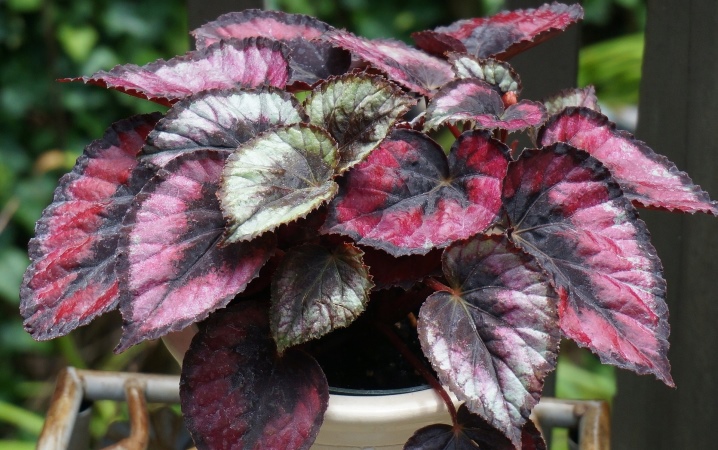
The leaf stalks are erect, pink-red, greenish or pink-lilac, pubescent, fragile and fleshy. The average height of the bush varies between 30-40 centimeters. The color of the leaves of royal begonia depends on its species and varietal characteristics. Among the dizzying variety of species and varieties of royal begonias, there are also extremely original specimens with spotted and striped leaves.
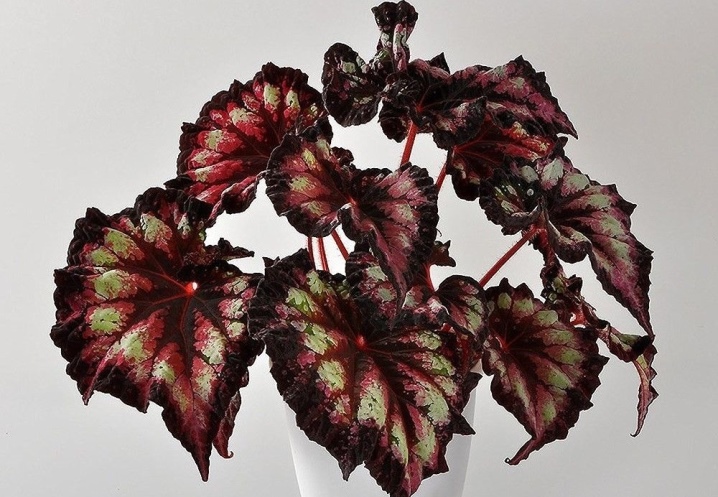
Chocolate Cream is a hybrid variety of royal begonia with intricately shaped and colored leaves... The plant forms a compact bush up to 25-30 centimeters high. The leaves are rounded, with a pointed apex, twisted into a flat spiral at the base. The center of the leaf, veins and scalloped edges are colored burgundy purple. A wide spiral strip running in the middle of the leaf plate has a silvery-green color.
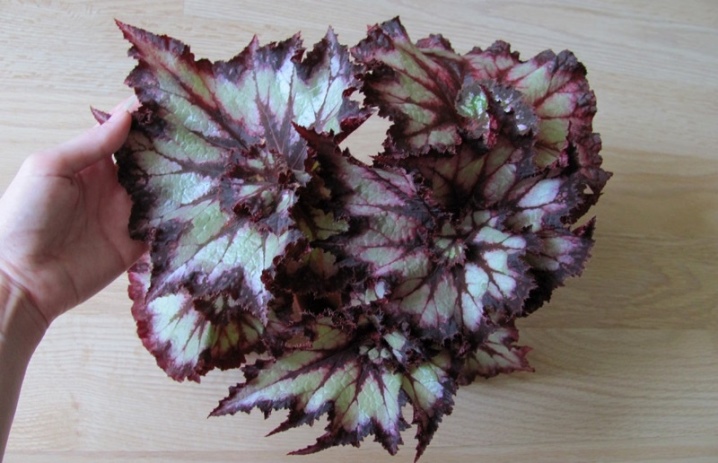
Stained Glass is a compact royal begonia with asymmetrical elongated leaves. The height of an adult plant varies from 25 to 30 centimeters. The central part of the leaf plate is decorated with a large ruby-violet spot, repeating in its outlines the shape of the leaf. The spot is surrounded by a wide gray-green stripe with a mother-of-pearl sheen.
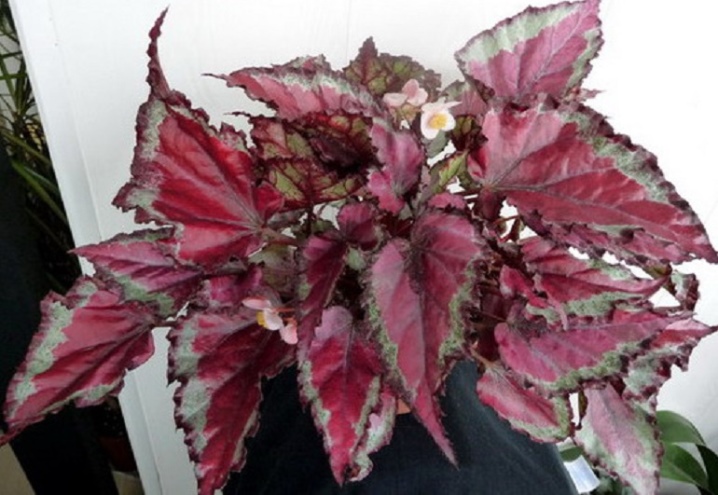
Zebrina purple is an unpretentious perennial houseplant, which is a representative of the Kommelin family. The homeland of this plant is considered to be the tropical regions of North America. Zebrina has long, creeping shoots, covered with succulent rounded leaves with a pointed tip. The central part of the leaf plate is decorated with a longitudinal violet-purple stripe. The sides of the leaf are colored pearlescent green and light purple. Below the leaf blade may have a gray-greenish or pale pinkish-purple color.
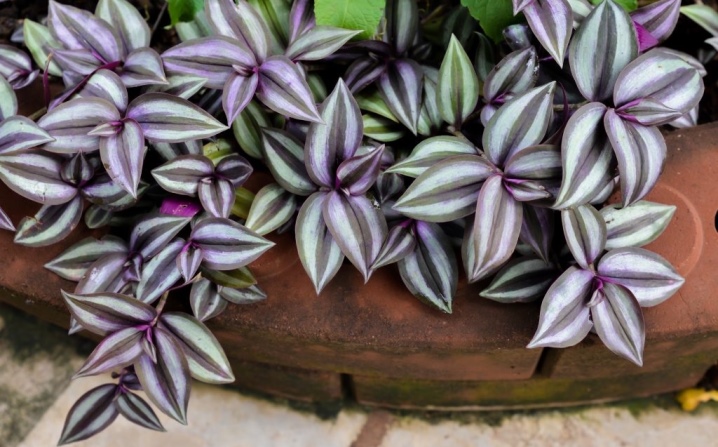
Zebrina purple is one of the most unpretentious indoor plants. It is able to withstand slight shading, short-term drought, and a lack of moisture in the air. However, this plant acquires the maximum decorative effect in the most comfortable conditions of existence.
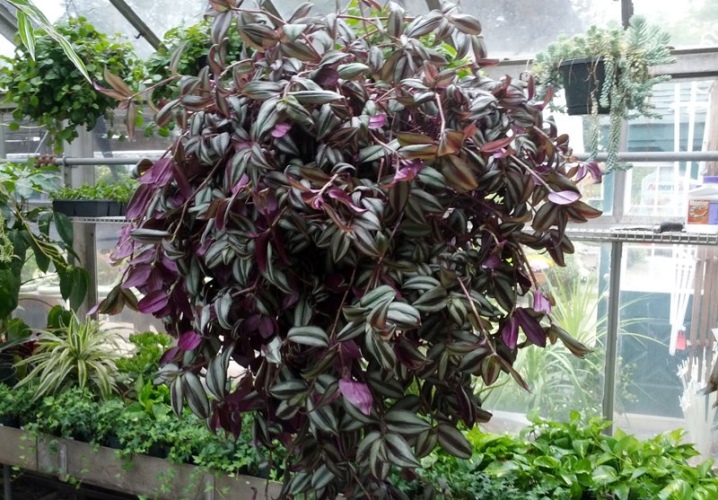
They mean:
- abundant but diffused lighting (not direct sunlight);
- regular watering (once every 2-3 days);
- periodic spraying of the plant;
- loose nutritious soil.
Experienced growers do not recommend placing this plant in direct sunlight. Bright sunlight can cause the bright color of the zebrin leaves to fade.
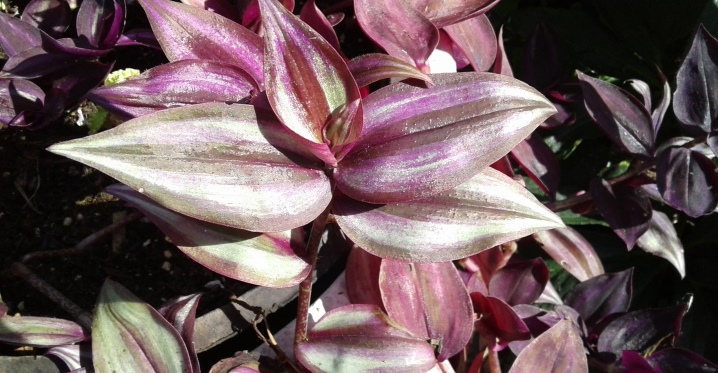
Irezine is an ornamental perennial plant of the Amaranth family. In the wild, this exotic is found in Brazil, Ecuador, Australia, and the Antilles. The plant is a compact, multi-stemmed bush covered with large rounded leaves. The color of the leaves ranges from purple-cherry to red-violet. The upper side of the leaf plates is decorated with bright pink veins.
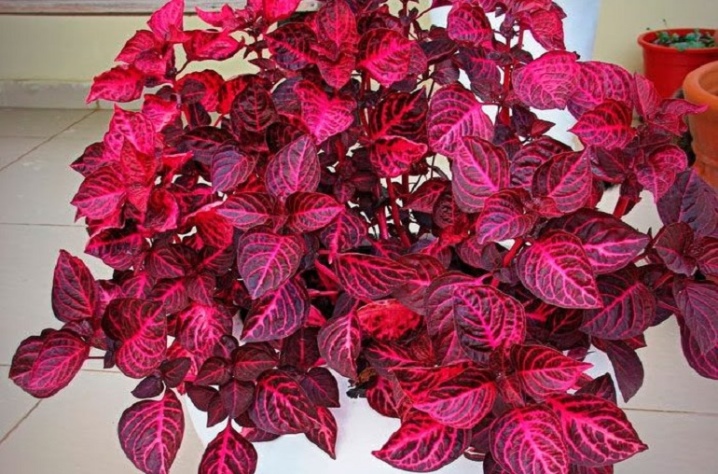
Irezine belongs to unpretentious plants that can easily tolerate drought, moisture deficit in the soil.
So that the plant does not lose its decorative effect as it grows, flower growers recommend regularly pinching its stems.
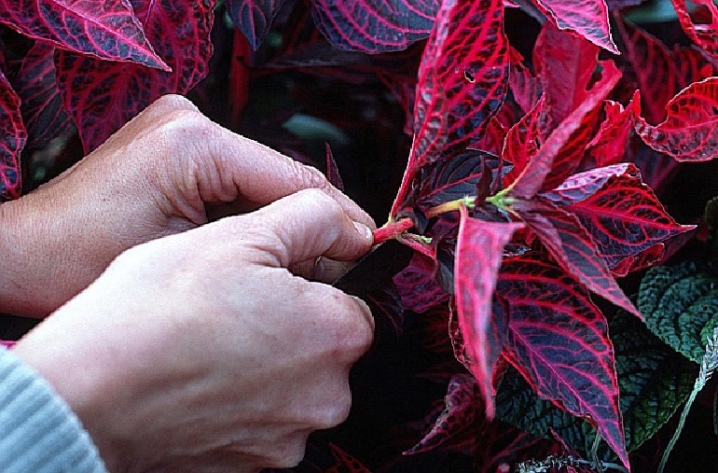
To make the flower feel comfortable he should provide a sufficient amount of soft, diffused light throughout the day, a stable temperature at 20 ° C and weekly spraying. It is recommended to transplant this perennial every 2-3 years.
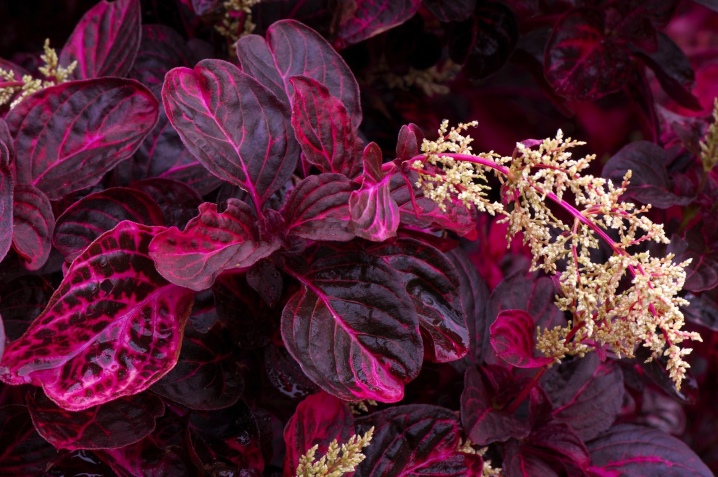
You can get acquainted with the peculiarities of caring for irezine in the following video.































The comment was sent successfully.